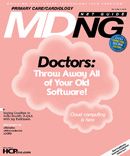Flexible Computer Screens May Soon Be Ready to Roll
Dr. Bertman discusses flexible screen computers.
Before I launch into this month’s topic, I would be remiss if I failed to acknowledge the technological phenomenon sweeping the nation this spring. I am speaking, of course, about the “magical and revolutionary” iPad, which hit stores April 3 and almost immediately altered the course of history as we know it. Or so the hype would have us believe.
Don’t get me wrong: the iPad is a cool new device, but its applications to this point don’t seem as absolutely essential as its proponents would have us believe. So, while the rest of the world focuses on the iPad, I’m actually more interested in another recent development that might end up having just as great an impact on all our lives: flexible screen technology. I know, it’s not nearly as sexy as whatever the latest iThingy is, but trust me, if you haven’t heard about flexible screen technology yet, you will soon.
That’s because the latest research indicates that flexible and even “rollable” displays, a space-age concept touted for years in movies like Minority Report and the Harry Potter series, are actually just around the corner. Imagine computers that can be folded up and put in your pocket, televisions that can be bent to view, and of course, cool new tools for your practice.
About two years ago, a company called Polymer Vision introduced e-Readius, an e-reader with a five-inch diagonal flexible screen, sporting a 320x240 resolution in 16 shades of gray. I haven’t used one myself, but the company claims its proprietary active-matrix electrophoretic display is as thin and light as paper, cannot be torn or broken, and can be rolled or folded into something as small as a finger.
Unlike the iPad, this product has not yet grabbed the public’s attention, which is interesting since it would be a boon to those who now get their daily news fix by scanning the headlines on an e-reader but miss the way they could roll up their old newspaper to swat a fly or smack their dog.
Looking further out into the future, Organic LED (OLED) may be the ultimate winner of this race. OLED is a light-emitting diode (LED) whose electroluminescent layer is composed of a film of organic compounds. The LED backlighting required by conventional liquid crystal displays (LCDs) is rigid, expensive, and complex to manufacture. On the other hand, OLED displays are easier to manufacture, more flexible and, as an added bonus, consume less energy.
That’s why industry giants like Sony, Samsung, and Kodak are all devoting significant time and money to the development of flexible OLED display screens. In October 2008, Samsung showcased the world’s thinnest OLED display, which was also the first to be bendable. It measured just 0.05 mm (thinner than a sheet of paper) and triggered a rumor that Apple would be using this OLED technology for their iPad.
The reality is that glitches, such as size and resolution limitations, and the difficulty of structuring the organic compounds so they won’t distort when bent, have kept designs from actually coming to market. But with the recent strides made with rollable displays (which, unlike the OLEDs, are enabled by plastic electronics rather than glass), we could be closer than ever to using these technologies in our everyday lives.
Practically speaking, the benefits of these flexible screens are boundless. Imagine, for instance, an EHR device as thin as paper, which can be as large as necessary, then completely rolled up or folded away when not in use. By closely mimicking paper, an EHR on this type of device might be more natural for many physicians to use during a patient encounter than a conventional PC or laptop. This may finally render obsolete the traditional paper chart, with its illegible writing, limited dynamic information, and all-round general unwieldiness.
I, for one, cannot wait for the day when I no longer have to lug my laptop around. And that is why I’m more excited about this developing story than the iPad which, frankly, is simply regurgitating existing technology (the iPhone) in a clever looking new package.
(Disclosure: I don’t have enough Apple stock.)
Dr. Bertman is Physician Editor-in-Chief of MDNG: Primary Care/Cardiology Edition. He is a Clinical Assistant Professorof Family Medicine at Brown University and president of AmazingCharts.com, a leading developer of EHR software. He is also the founder and president of AfraidToAsk.com, a consumer website focusing on personal medical topics. He is in private practice in Hope Valley, RI.
